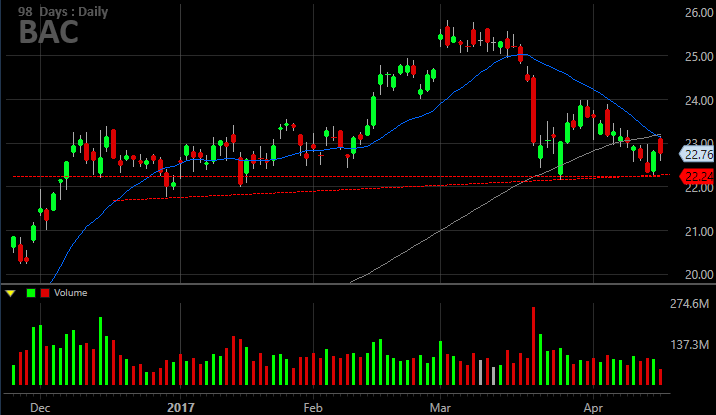Bank of America (BAC) Q1 Earnings Save Stock From Meltdown... For Now

In the grand scheme of things, considering JPMorgan & Chase (JPM) and Citigroup (C) had already posted rock-solid first quarter numbers, it comes as no surprise that Bank of America (BAC) did the same. What was surprising, however, was just how good they were, and how near-flawless they were. The company made progress in every possible aspect of its business, reversing a downtrend from the stock in the nick of time.
For the quarter ending in March, BofA earned 41 cents per share on $22.2 billion in revenue. Both were up from the year-ago bottom line of 28 cents per share and top line of $19.7 billion. And, both topped expectations for a profit of 35 cents per share and sales of $21.6 billion.
Everything was better, across the board. Net interest income of $11.1 billion was up 5.0%, while noninterest income -- like stock-trading and management fees -- grew 9%; bond trading was up considerably. The consumer and institutional loan portfolios both grew as well, as did the amount of assets under the management of the company's wealth management arm. Conversely, loan losses continue to fall. The provision for credit losses was off 16% on a year-over-year-basis, while net charge-offs fell 13%.
Perhaps most important, the company made progress on its ROTCE, or return on average tangible common equity. It grew from Q4's 9.9% to 10.3%. While that's still less than Bank of America's goal of 12.0%, a ROTCE of 10.3% is still more than respectable within the banking world.
In a bigger sense though, last quarter's results from BofA confirm its semi-checkered past is truly in the past.
Like all banks, Bank of America struggled in the wake of the subprime loan meltdown. That stumble was followed by trouble with its energy/oil loan portfolio following the 2014 implosion of crude oil prices. Unlike most of its peers though, Bank of America was slow to find the Fed's full blessing after going through the regulatory "stress trust." The Federal Reserve largely kept the brakes on Bank of America's dividend growth, and also required the bank to up its reserves of higher-quality capital (this crimping its ability to grow). After the first quarter report though, those headwinds are decidedly in the rear-view mirror. The company is now starting its second full-year of strong earnings growth, and analysts expect more of the same -- and actually better margins -- going forward.
The good news couldn't have come at a better time either.
Although much of the pullback since early March can be chalked up to an exceedingly frothy February. Nonetheless, the downtrend's rekindling in early April posed a real threat to BAC shares. A couple of different support levels -- one horizontal, and the other rising -- came into play. Had the stock broken under either or both of those support levels this week, the selling floodgates could have opened. Rather, those floors acted as floors on Monday, prompting a turnaround that saw some follow-through today. For the time being at least, BofA has escaped a bigger meltdown.
Don't get too bullish just yet. As the chart also shows, Bank of America shares bumped into the 20-day moving average line early in Tuesday's session and have rolled over. The stock could still very easily peel back until it breaks under those support lines. The selling fireworks could still start in earnest then. From a fundamental perspective though, such a pullback would be against the grain of the results trend and outlook, and be a buying opportunity.
On the flipside, never try and catch a falling knife. Make sure any meltdown is good and done before tiptoeing in.
At the same time, know that BAC could still evade a pullback and jolt higher instead. It would just need to clear the 20-day moving average line (blue) and the 100-day moving average line (gray) first.

